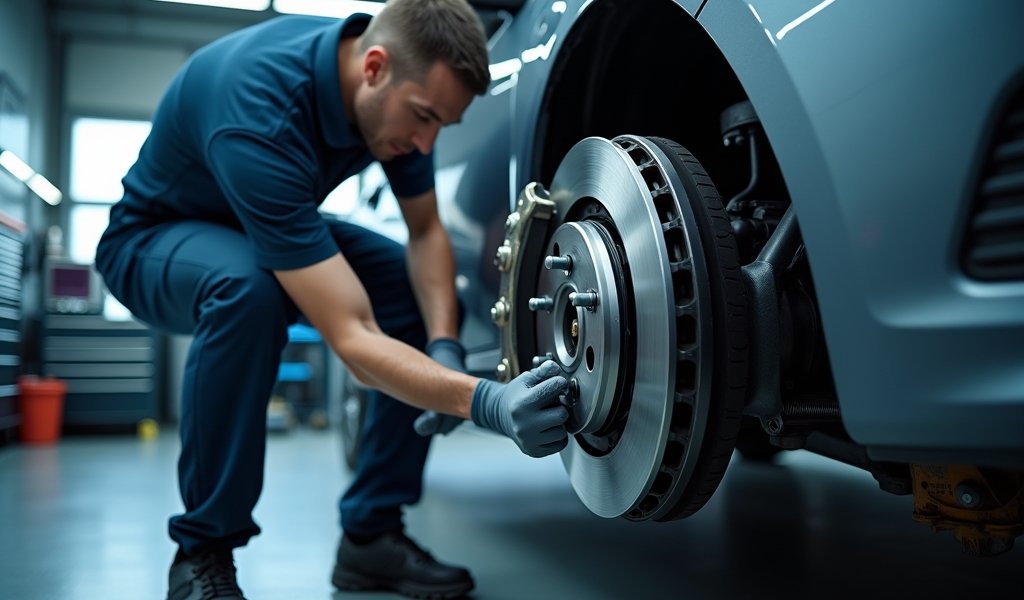Overview
This article outlines seven essential maintenance tips for Anti-lock Braking Systems (ABS), explaining how regular inspection, proper brake fluid maintenance, recognizing warning signs, sensor care, conventional brake upkeep, understanding normal ABS operation, and knowing when to seek professional help can prevent costly repairs and ensure optimal safety performance. ABS prevents wheel lockup during emergency braking, maintaining steering control even in slippery conditions, making proper maintenance crucial for driver safety and vehicle performance.
Table of Contents
- Understanding ABS Brakes: What They Are and Why They Matter
- How ABS Works: The Science Behind Safer Stops
- Tip #1: Regular System Inspection – Catching Issues Early
- Tip #2: Brake Fluid Maintenance – The Lifeblood of Your ABS
- Tip #3: Recognize Warning Signs Before They Become Problems
- Tip #4: Proper Sensor Care – Keeping Your ABS’s “Eyes” Clean
- Tip #5: Don’t Neglect Conventional Brake Components
- Tip #6: Learn to Feel Normal ABS Operation
- Tip #7: When to Seek Professional Help
- Conclusion: Keeping Your ABS in Top Shape
- Frequently Asked Questions
Understanding ABS Brakes: What They Are and Why They Matter
Let me start with something I see in my shop all too often: a driver who doesn’t understand what that ABS light on their dash means until it’s too late. Anti-lock Braking Systems (ABS) aren’t just another fancy car feature – they’re arguably one of the most important safety innovations in automotive history.
In the simplest terms, ABS prevents your wheels from locking up when you slam on the brakes. Without ABS, hitting the brakes hard (especially on slick surfaces) could send you into an uncontrollable skid. With properly functioning ABS, you maintain steering control even during panic stops. Think of it as having a professional driver pumping your brakes perfectly during an emergency – except this system reacts hundreds of times faster than any human could.
I’ve been fixing brakes for over 15 years, and I can tell you with certainty that a well-maintained ABS system could be the difference between a close call and a serious accident. That’s why understanding how to maintain your ABS is so crucial for every driver on the road today.
How ABS Works: The Science Behind Safer Stops
Before we jump into maintenance tips, let’s take a quick peek under the hood at how these systems actually work. Don’t worry – I’ll keep this simple and practical.
Your ABS is essentially a sophisticated computer-controlled system that monitors wheel speed through sensors at each wheel. When you hit the brakes hard, the system compares the speed of all wheels. If it detects that one or more wheels are about to lock up (stop spinning), it rapidly pulses the brake pressure at that wheel – sometimes 15-20 times per second!
This pulsing is what creates that distinctive vibration you feel in the pedal during emergency braking. That vibration is your clue that the ABS is working exactly as designed. The system is rapidly releasing and reapplying your brakes to maintain the sweet spot between maximum braking power and tire grip.
The main components include wheel speed sensors, an electronic control unit (the brain), a hydraulic control unit with valves and pumps, and of course, all the conventional braking components. When working together perfectly, this system provides the optimal combination of stopping power and steering control.

Tip #1: Regular System Inspection – Catching Issues Early
The first rule of ABS maintenance is simple: don’t wait until that warning light comes on. Prevention beats repair every time in my garage. I recommend incorporating a basic ABS inspection into your standard car service checklist, especially before winter driving season or long road trips.
Start with a visual inspection of accessible components. Look for any damaged wiring leading to wheel sensors, check for brake fluid leaks around the ABS module (typically located near the master cylinder), and ensure all mounting brackets are secure. Corrosion on electrical connections is particularly problematic for ABS systems, so pay special attention to any exposed connectors.
While the system is complex, there are some basic checks you can do yourself:
- Check all fuses related to the ABS system
- Inspect visible wiring for damage, especially near wheel wells
- Look for fluid leaks around the ABS module and hydraulic lines
- Monitor your dashboard for any intermittent ABS light flashes
I tell my customers that an ounce of prevention here is worth pounds of cure. A quick inspection every few months can save you hundreds in repair costs down the road. Plus, studies from the National Highway Traffic Safety Administration show that properly functioning ABS systems significantly reduce accident rates on wet and icy roads.
Tip #2: Brake Fluid Maintenance – The Lifeblood of Your ABS
If there’s one thing that makes me shake my head in my shop, it’s seeing vehicles with brake fluid that hasn’t been changed in years. Brake fluid is hygroscopic – a fancy word meaning it absorbs moisture from the air over time. This moisture contamination is particularly problematic for ABS systems.
Here’s why: Water-contaminated brake fluid has a lower boiling point. During intense braking (precisely when you need ABS the most), the fluid can actually boil inside the lines, creating vapor pockets that don’t transmit hydraulic pressure effectively. The result? Your sophisticated ABS system becomes about as useful as a bicycle brake.
More concerning, moisture promotes corrosion inside your ABS module’s delicate valves and passages. I’ve replaced entire ABS units that were internally corroded – a repair that can cost upwards of $1,000 – all because someone skipped a $100 brake fluid flush.
Most manufacturers recommend changing brake fluid every 2-3 years regardless of mileage. Check your fluid by looking at the reservoir – fresh fluid is clear with a slight amber tint. If it’s dark brown or black, it’s overdue for replacement. This simple maintenance step is one of the most critical parts of a complete car service.
Remember, your ABS can only work with the fluid it’s given. Give it clean, fresh fluid, and it’ll be ready when you need that emergency stop.
Tip #3: Recognize Warning Signs Before They Become Problems
Your car is constantly trying to communicate with you – you just need to know the language. When it comes to ABS issues, there are several warning signs that should never be ignored, even if they seem minor at first.
The most obvious is the ABS warning light on your dashboard. Unlike some warning lights that might indicate a minor issue, an illuminated ABS light means the system has detected a fault serious enough that it may not function properly during an emergency stop. Don’t gamble with this one – get it checked out promptly.
Beyond the warning light, pay attention to how your brake pedal feels. A properly functioning ABS system should give you a firm, consistent pedal feel during normal braking. If you notice pulsations during light braking (not emergency stops), a pedal that gradually sinks toward the floor, or unusual sponginess, these could indicate issues with the ABS hydraulic unit or conventional brake components.
Unusual noises are another telltale sign. While ABS normally makes noise during activation (that grinding/pumping sound during hard stops), you shouldn’t hear these sounds during normal driving or light braking. Grinding, clicking, or whirring sounds outside of emergency stops warrant investigation.
Finally, watch for changes in your vehicle’s stopping behavior. Pulling to one side during braking, increased stopping distances, or erratic braking performance can all indicate ABS system issues. As Car and Driver explains, proper ABS function should provide predictable, controlled stops even in challenging conditions.

Tip #4: Proper Sensor Care – Keeping Your ABS’s “Eyes” Clean
If your ABS system is the brain of your braking system, then wheel speed sensors are its eyes. These small magnetic sensors monitor how fast each wheel is rotating, sending that critical information to the control module. When they get dirty or damaged, your ABS can’t “see” what’s happening at each wheel.
Wheel speed sensors are typically located near the wheel hub or inside the wheel bearing assembly. They’re particularly vulnerable to road grime, salt, and metal particles (they are magnetic, after all). In snowy regions where road salt is common, I see failed sensors all winter long in my shop.
You’ll often notice sensor issues as intermittent ABS light activation, especially when driving on rough roads or through puddles. Some vehicles may also display unusual behavior at low speeds, with the ABS activating inappropriately during gentle stops.
While sensor replacement sometimes becomes necessary, many issues can be resolved with a thorough cleaning. If you’re comfortable working on your car, you can often access these sensors by removing the wheel. Clean them using electrical contact cleaner (never use WD-40 or other lubricants on electrical components) and a soft brush. Be extremely gentle – these sensors are delicate and expensive to replace.
For those living in areas with harsh winters, I recommend having your sensors cleaned and inspected as part of your fall maintenance routine. It’s a small step that can prevent major headaches when road conditions are at their worst.
Tip #5: Don’t Neglect Conventional Brake Components
Here’s something many drivers miss: your sophisticated ABS system still relies on conventional brake components to actually stop your vehicle. The ABS only modulates the pressure – it’s still your regular brakes doing the hard work.
This means your brake pads, rotors, calipers, and master cylinder need to be in top shape for the ABS to work effectively. Think of it like having a world-class orchestra conductor with out-of-tune instruments – even perfect direction can’t make up for basic component failures.
Pay particular attention to brake pad condition. Worn pads reduce overall braking effectiveness and force your ABS to work harder than necessary. Most manufacturers recommend replacing pads when they reach 3-4mm thickness, but performance begins to degrade well before they reach the wear indicators. As part of learning how to service a car properly, understanding brake pad wear patterns is essential.
Brake rotor condition is equally important. Warped or grooved rotors can cause vibrations that might be confused with ABS activation. They also reduce braking effectiveness and increase stopping distances – precisely what your ABS is trying to minimize.
Don’t forget about brake fluid lines and the master cylinder. Aging rubber lines can expand under pressure, creating a spongy pedal feel and reducing ABS effectiveness. The master cylinder converts your foot pressure to hydraulic force – when it begins to fail, no amount of ABS wizardry can compensate.
I recommend a thorough inspection of all conventional brake components at least once a year, or every 12,000 miles, whichever comes first. This comprehensive approach ensures that your ABS has a solid foundation to work with.
Tip #6: Learn to Feel Normal ABS Operation
One of the best maintenance tools doesn’t cost a dime: your own awareness of how your ABS should feel when operating normally. Many drivers have never experienced their ABS activating in a controlled environment, so when it happens during an emergency, the sensation can be alarming.
I recommend finding an empty parking lot (ideally when slightly wet) and practicing a few controlled emergency stops from about 30mph. Press the brake pedal firmly and hold steady pressure. You’ll feel a pulsing or vibration through the pedal, often accompanied by a mechanical buzzing or grinding sound. This is completely normal!
What you’re feeling is the ABS rapidly modulating brake pressure to prevent wheel lockup. Many drivers instinctively release pressure when they feel this sensation – exactly the opposite of what you should do. Maintain firm, steady pressure until the vehicle comes to a complete stop.
By familiarizing yourself with these sensations in a controlled environment, you’ll be better prepared to use your ABS effectively during a real emergency. You’ll also develop a baseline understanding of how your system should feel when working properly, making it easier to identify when something changes or feels wrong.
This practice isn’t just about maintaining your ABS – it’s about maintaining your skills as a driver. Even the best-maintained ABS system requires proper driver input to work effectively. As the Insurance Institute for Highway Safety notes, driver familiarity with assistance systems significantly improves their effectiveness in emergency situations.
Tip #7: When to Seek Professional Help
While I’m a big advocate for DIY maintenance, there comes a point where professional equipment and expertise become necessary. Modern ABS systems are incredibly complex, integrating with stability control, traction control, and sometimes even autonomous braking systems.
Here are the situations where I strongly recommend professional diagnosis:
- Persistent ABS warning light illumination
- Unusual ABS activation during normal driving
- Any changes in braking performance after hitting a pothole or curb
- Following any collision, even minor ones
- If you notice fluid leaking from the ABS module or hydraulic lines
Modern shops have specialized diagnostic equipment that can communicate directly with your ABS module, retrieving detailed error codes that pinpoint the exact nature of the problem. This targeted diagnosis can save you significant money by avoiding the “parts cannon” approach of replacing components unnecessarily.
When selecting a shop for ABS work, look for ASE certification specifically in brake systems. Ask whether they have dedicated ABS diagnostic equipment for your specific make of vehicle. Factory-specific scanners often provide more detailed information than generic code readers.
Remember that some repairs may require programming or calibration procedures that simply aren’t possible without dealer-level equipment. In these cases, even the most talented DIY mechanic needs professional assistance.
Conclusion: Keeping Your ABS in Top Shape
Your ABS braking system isn’t just another car feature—it’s a sophisticated safety system designed to help you maintain control during critical moments. Through proper maintenance and understanding, you can ensure it’s ready to perform flawlessly when you need it most.
Let’s recap our seven proven tips for maintaining your ABS system:
- Perform regular visual inspections of ABS components
- Maintain clean, fresh brake fluid by changing it every 2-3 years
- Learn to recognize warning signs before they become serious problems
- Keep wheel speed sensors clean and functioning properly
- Don’t neglect conventional brake components that support the ABS
- Familiarize yourself with normal ABS operation through practice
- Know when to seek professional help for complex issues
These maintenance practices aren’t just about avoiding repair costs—though they certainly help with that. They’re about ensuring that in that split-second when you need to avoid an accident, your braking system responds exactly as designed.
In my years working as a mechanic, I’ve seen how well-maintained vehicles consistently outperform and outlast those that receive only reactive maintenance. Your ABS system is no exception to this rule. A little attention today could quite literally save your life tomorrow.
Remember, your braking system is only as strong as its weakest component. By taking a holistic approach to ABS maintenance, you’re investing in your safety and the safety of everyone who shares the road with you.
Frequently Asked Questions
How do I know if my ABS is working properly?
Your ABS is working properly if the warning light doesn’t illuminate on your dashboard and you feel a pulsating sensation in the brake pedal during hard stops. You should also maintain steering control during emergency braking situations.
How often should ABS brake fluid be changed?
Most manufacturers recommend changing brake fluid every 2-3 years regardless of mileage. Vehicles driven in humid climates or used for towing may require more frequent service.
Can I drive with the ABS light on?
While the vehicle will still brake, an illuminated ABS light means the anti-lock function is disabled. This significantly reduces safety in emergency stops or slippery conditions, so have it inspected as soon as possible.
What’s the difference between regular brakes and ABS?
Regular brakes simply apply stopping force when you press the pedal, potentially locking wheels during hard braking. ABS monitors wheel speed and rapidly pulses brake pressure to prevent lockup, maintaining steering control during emergency stops.
Are ABS repairs expensive?
ABS repairs vary widely in cost—from $100 for a simple wheel sensor replacement to $2,000+ for a complete hydraulic control unit. Regular maintenance is significantly less expensive than emergency repairs.

